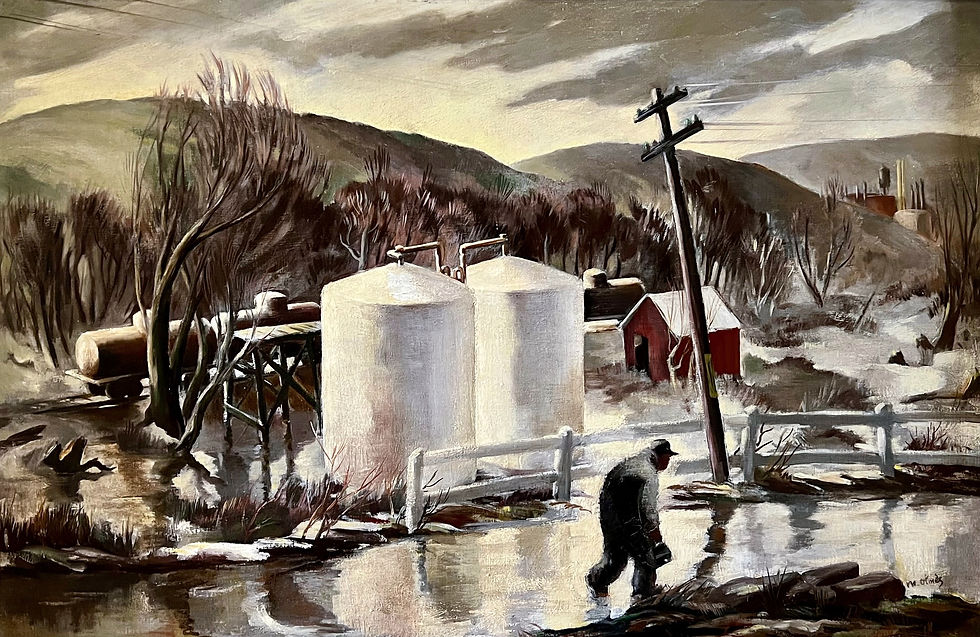Mildred Olmes (1906 - 1994)
- walthercb1
- Jun 11
- 3 min read
Updated: Nov 6

Lonely Road (perhaps also known as The Road Home), c. 1930s, oil on Masonite, signed lower right, 20 x 30 inches, label verso reads: “Painted CA. 1930s Oil City, PA Sister to Jo (Yvonne) Allmon,” likely exhibited New Year Show, Butler Art Institute, Youngstown, OH, 1948 (label verso), perhaps exhibited at the 47th Annual Exhibition of American Paintings & Sculpture, Art Institute of Chicago, October 22 – December 6, 1936 (Note: there is a second remnant of an exhibition label verso. The subject matter, style, overall appearance and the date ascribed to this work in the label verso, all suggest this painting was produced in the mid -1930s and likely not around the time of the Butler New Year Show in the late 1940s. Olmes is known to have painted a work entitled The Road Home, which was exhibited at the Art Institute of Chicago and Olmes’ two person exhibition at the Baldwin Museum in 1938 (see Exhibition of Watercolors, The Evening Independent, Massillon, OH, November 15, 1938 – “Typical of her best work is an oil “The Road Home,” which was accepted at the annual exhibition of American paintings at the Chicago Art Institute. This picture was also chose for a traveling exhibit.”). It is possible that this work is the painting known as The Road Home.)
SOLD
In Lonely Road, Mildred Young Olmes depicts a scene near her hometown of Oil City, Pennsylvania, a historically famous site known as one of the birthplaces of the American oil industry which is reflected in the railroad tanker cars and oil storage tanks in the center of the composition and the refineries in the distant hills. In the foreground, Olmes centers a lonely oil worker heading home after a long day in the oil fields. Edwin L. Drake drilled the first successful commercial oil well in nearby Titusville, Pennsylvania, in 1859. This sparked the Pennsylvania oil rush, and Oil City became a central hub for the burgeoning industry. During the late 19th and early 20th centuries, Oil City thrived as a boomtown, attracting oil barons and speculators, and it became a base of operations for major companies such as Pennzoil, Quaker State, and Wolf’s Head. The city grew around the confluence of Oil Creek and the Allegheny River, making it ideal for shipping oil by barge and later by rail, as depicted in Lonely Road. By the 1920s, a decade before Olmes' painting, the largest part of American oil production had moved west to Texas and Oklahoma, but oil wells in western Pennsylvania continued to pump into the Great Depression providing some measure of economic stability for the region.
Mildred Young Olmes was a painter, printmaker, craftsperson, designer and illustrator. Olmes obtained her art degree from the Carnegie Institute and also studied at the Tyler School of Fine Art in Philadelphia and in Europe at the Royal University for Foreigners in Perugia, Italy and in Paris at the Academie Julian. She spent most of her career working in Pennsylvania and Ohio, where she exhibited frequently at the Carnegie Institute, Canton Art Institute, the Butler Art Institute, the Massillon Museum, the Ohio State Fair, the Akron Art Institute, the Ohio Watercolor Exhibition, the Ohio Drawing Exhibition, and the Ohio Valley Exhibition. She also exhibited at the Paris Salon, the Art Institute of Chicago and the Corcoran Galleries in Washington, DC. She completed murals in Canton, Toledo, West Chester, PA, and Massillon. Olmes’ work is in the collections of the Massillon Museum of Art and the Canton Art Institute. She is listed in Who Was Who in American Art and other standard references.
.png)



Comments